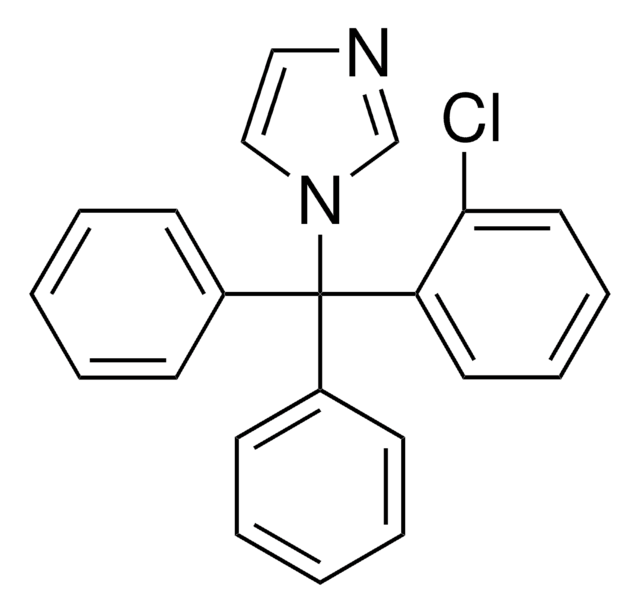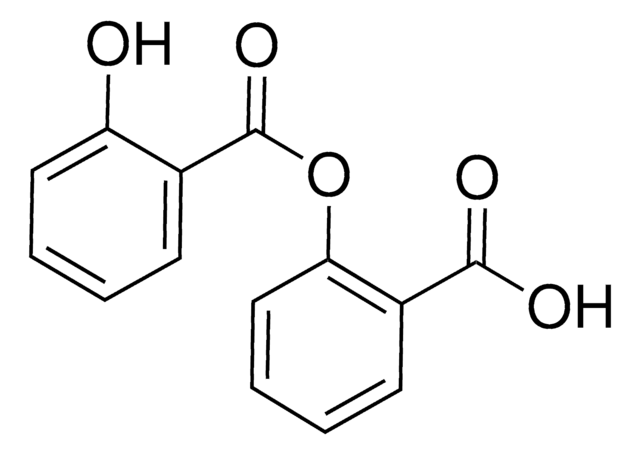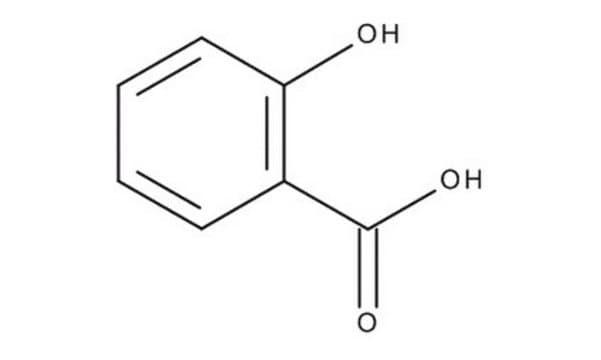Y0001460
Acetylsalicylic acid for peak identification
European Pharmacopoeia (EP) Reference Standard
Synonym(s):
Acetylsalicylic acid, 2-Acetoxybenzoic acid, O-Acetylsalicylic acid, ASA, Aspirin
About This Item
Recommended Products
grade
pharmaceutical primary standard
API family
aspirin
manufacturer/tradename
EDQM
mp
134-136 °C (lit.)
application(s)
pharmaceutical (small molecule)
format
neat
storage temp.
2-8°C
SMILES string
CC(=O)Oc1ccccc1C(O)=O
InChI
1S/C9H8O4/c1-6(10)13-8-5-3-2-4-7(8)9(11)12/h2-5H,1H3,(H,11,12)
InChI key
BSYNRYMUTXBXSQ-UHFFFAOYSA-N
Gene Information
human ... PTGS1(5742) , PTGS2(5743)
Looking for similar products? Visit Product Comparison Guide
General description
Application
Biochem/physiol Actions
Packaging
Other Notes
related product
Signal Word
Warning
Hazard Statements
Precautionary Statements
Hazard Classifications
Acute Tox. 4 Oral
Storage Class Code
11 - Combustible Solids
WGK
WGK 1
Flash Point(F)
482.0 °F
Flash Point(C)
250 °C
Regulatory Listings
Regulatory Listings are mainly provided for chemical products. Only limited information can be provided here for non-chemical products. No entry means none of the components are listed. It is the user’s obligation to ensure the safe and legal use of the product.
ISHL Indicated Name
Substances Subject to be Indicated Names
ISHL Notified Names
Substances Subject to be Notified Names
JAN Code
Y0001460:
Y0001460-1EA:
Choose from one of the most recent versions:
Certificates of Analysis (COA)
Sorry, we don't have COAs for this product available online at this time.
If you need assistance, please contact Customer Support.
Already Own This Product?
Find documentation for the products that you have recently purchased in the Document Library.
Customers Also Viewed
Articles
Separation of Acetaminophen, meets USP testing specifications, 98.0-102.0%, powder; Caffeine, meets USP testing specifications, anhydrous; Benzoic acid, meets USP testing specifications; Aspirin, meets USP testing specifications
Protocols
Separation of Acetylsalicylic acid, analytical standard; Salicylic acid, BioXtra, ≥99.0%
Separation of Salicylic acid, meets analytical specification of Ph. Eur., BP, USP, 99.5-100.5% (calc. to the dried substance); Acetylsalicylic acid, purum, ≥99.0% (HPLC)
Separation of 4-Hydroxybenzoic acid; Acetylsalicylic acid; Benzoic acid; Salicylic acid; Ethyl 4-hydroxybenzoate
HPLC Analysis of Benzoic Acid Derivatives on Ascentis® C18
Our team of scientists has experience in all areas of research including Life Science, Material Science, Chemical Synthesis, Chromatography, Analytical and many others.
Contact Technical Service






